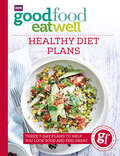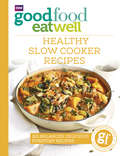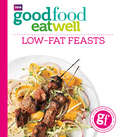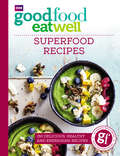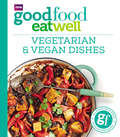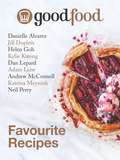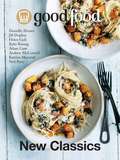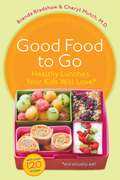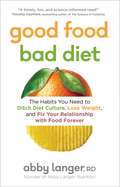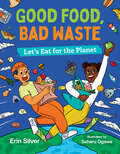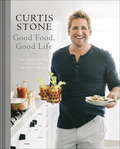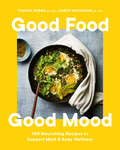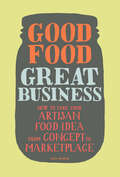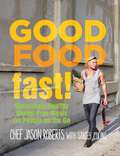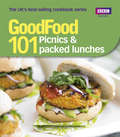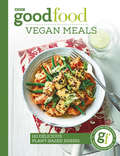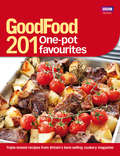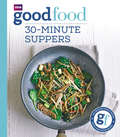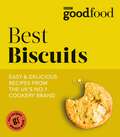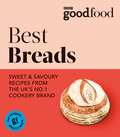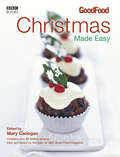- Table View
- List View
Good Food Eat Well: Healthy Diet Plans
by Good Food GuidesGlowing skin, better sleep, loads more energy and improved overall health.... These are things we all want for our bodies. Good Food have combined the expertise of their nutritionists and the imagination of their test kitchen to create three diet plans. Each one targets a different area - from making you look and feel your best to boosting immunity and improved digestion, as well as an entirely vegetarian option. The plans are structured for you, supplying under 1,500 calories each day, and providing you with more than your 5 a day. The book also includes optional healthy snacks and treats if your goal isn't weight loss. All the recipes are short and simple, with easy-to-follow steps, and all are accompanied by a full-colour photograph of the finished dish.
Good Food Eat Well: Healthy Slow Cooker Recipes
by Good Food GuidesFor those of us with busy lifestyles and little time to spare, slow cookers are a priceless helping hand in the kitchen - with as little as 10 minutes spent preparing a dish at the beginning of the day, you can enjoy delicious food a few hours later without slaving away at a hot stove. It isn't just high calorie, high fat recipes that you can make though - this essential guide from the experts at Good Food will show you to make delicious, healthy and balanced recipes in your slow cooker. From curries, chillis, soups and guilt-free puddings, through to fresh ideas for stews, and vegetarian meals, there is a slow-cooked meal for everyone.Accompanied throughout with full-colour photographs and a nutritional breakdown of every recipe, this collection of Good Food's favourite triple-tested slow cooker recipes will work first time, every time.
Good Food Eat Well: Low-Sugar Recipes
by Good Food GuidesSugar can have a very harmful affect on our health and well being and Good Food: Low Sugar Recipes is your perfect companion to cutting harmful levels out of your diet whilst still eating delicious meals. With breakfasts, lunches, dinners and snacks as well as tempting desserts and baking ideas, Good Food: Low Sugar Recipes is packed full of easy recipes, full of flavour. From Bacon and parsley hotcakes to Portabello burgers and lemon drizzle cake, every recipe for every occasion can now be low in sugar. All recipes have been carefully selected and triple-tested by the trusted team at Good Food, and with full nutritional breakdown and colour photograph to accompany each dish, this is your comprehensive guide to a healthier and happier, low-sugar lifestyle. Part of Good Food’s exciting new Eat Well range, for a healthy and happy you.
Good Food Eat Well: Low-fat Feasts
by Good Food GuidesIf you like good food, but want to stay healthy or lose weight, try Good Food: Low-fat Feasts. Divided into Starters and Light Meals; Pasta, Rice and Noodles; Meat; Fish and Seafood; Veggie-friendly and Desserts, you're guaranteed to find a delicious, low-fat recipe for every occasion. Whether you choose Chicken with Coriander Tomato Sauce, Nutty Stuffed Peppers or Tequila Sunrise Sorbet, every recipe has been tried and tested by the Good Food team to ensure fantastic results, every time you cook. The recipes are all short and simple with easy-to-follow steps, using readily available ingredients and are accompanied by a full-colour photograph of the finished dish. This edition is revised and updated with delicious new recipes and a fresh, contemporary design. Part of Good Food’s exciting new Eat Well range, for a healthy and happy you.
Good Food Eat Well: Superfood Recipes
by Good Food GuidesWe’ve all heard of super-foods but it’s hard to know where to start and to work out which foods are the most beneficial for health and well-being.Good Food Eat Well: Simple super-food recipes is a comprehensive collection of 150 fresh and reasonably priced recipes which make eating healthily straightforward and achievable. All of our recipes have been chosen for their health-giving ingredients, whether that’s memory-boosting turmeric or stamina-enhancing beetroot. So whether you’re looking to improve your health, lose a few pounds or just want to feel lighter and brighter, our super-food recipes will help you achieve your goal. All the recipes are short and simple with easy-to-follow steps, and all are accompanied by a full-colour photograph of the finished dish.
Good Food Eat Well: Vegetarian and Vegan Dishes
by Good Food GuidesWhether the rise for the popularity in vegan and vegetarian recipes is moral, financial or just that some people want to eat more plant-based meals, the Good Food team have made sure their recipes are balanced, nutritional and delicious.In Good food Eat Well: Vegan and Vegetarian there are recipes to cover groups of any size and occasion. From big batch cereals and smoothies to help you start the day right to quick meals, snacks and desserts for one alongside relaxed buffet ideas and formal entertaining dishes for a crowd there’s heaps of inspiration for vegan and vegetarian cooking that everyone will want to try. All of these 100 triple-tested recipes from the Good Food experts are vegetarian and, where possible, they’ve been adapted or there are suggestions on how to make them vegan too.
Good Food Favourite Recipes
by Ardyn BernothOver 100 recipes chosen by Good Food editor Ardyn Bernoth from the outstanding professional cooks she charges every week to bring us recipes for the seasonal food they are passionate about. Here are inspiring, delicious, easy weeknight dishes along with plenty to make your guests gasp such at Danielle Alvarez’s Chocolate, butterscotch and raspberry trifle and Neil Perry’s Spicy braised lamb with apricots, pistachios and roast pumpkin. The recipes have been clearly labelled for those looking for gluten-free, vegetarian and vegan options and every recipe has an accompanying photograph. The chapters include: SoupsVeggies, Sides and SaladsPasta, Grains, Eggs and TartsFish and SeafoodChicken, Duck and MeatDesserts and Treats
Good Food New Classics
by Ardyn BernothThe much-requested second collection of best-loved and requested recipes from the stellar Good Food team. More than 100 classic recipes are given a fresh, extra delicious twist by eight of Australia&’s best-loved chefs. Katrina Meynink adds toasted seeds and pomegranate to her sweet potato, carrot and cumin soup. Kylie Kwong shares her heavenly Vegetarian special fried rice. Adam Liaw infuses slow cooked lamb with Tunisian flavours. The schnitty goes meat-free with Jill Dupleix&’s inspired eggplant schnitzel with leek pickles and labna. Neil Perry gives us a chicken Kiev with garlic butter that is baked instead of fried. Danielle Alvarez has updated the salad Lyonainasie with shredded cabbage and mustard greens. Andrew McConnell&’s addictive spiced hot cross buns have some sour dried cherries added to the mix. And Helen Goh&’s Irish coffee cake has Bailey&’s Irish Cream in the filling! Created for home cooks, these are inspirational, easy weeknight dinners, along with plenty of delicious dishes to impress your guests.
Good Food to Go: Healthy Lunches Your Kids Will Love
by Brenda Bradshaw Cheryl MutchGood Food to Go is the ultimate guide to packing healthy lunch boxes with food that kids will enjoy and parents can feel good about. Back-to-school means back-to-lunch-boxes, and the daily quandary of what to put in them. With this new book, two working moms - one a teacher, one a pediatrician - offer creative ideas for balanced lunches and nutritious snacks, as well as up-to-date health tips that will make packing lunch a joy and not a chore. Given that children consume approximately one third of their daily calories at school, what goes into kids' lunch boxes is vital to their well-being. Yet it still needs to be hot enough, cold enough or crisp enough to withstand a morning in the cloakroom. (And with allergies on the rise many schools are now nut-free, eliminating that old standby: peanut butter.) Most important, the lunch needs to be kid-friendly and delicious because after all, the healthiest lunch isn't very healthy if it goes uneaten.Good Food to Go fuses the how-to's of creating wholesome, homemade lunches with the latest information on food and nutrition. Practical tips will help parents make environmentally conscious food choices and eliminate lunch-box waste to ensure children are eating for a healthier planet. Many of the recipes outline what can be done the night before, while others may be made in bulk and frozen, facilitating easy, last-minute lunches. Handy meal planners help to ensure that kids are eating a healthy variety of nutritious lunches throughout the week.From the Trade Paperback edition.
Good Food, Bad Diet: The Habits You Need to Ditch Diet Culture, Lose Weight, and Fix Your Relationship with Food Forever
by Abby LangerIn this science-based book, registered dietitian Abby Langer tackles head-on the negative effects of diet culture and offers advice to help you enjoy food and lose weight without guilt or shame.There are so many diets out there, but what if you want to eat well and lose weight without dieting, counting, or restricting? What if you want to love your body, not punish it? Registered dietitian Abby Langer is here to help. In her first-ever book, Abby takes on our obsession with being thin and the diets that are sucking the life, sometimes literally, out of us. For the past twenty years, she has worked with clients from all walks of life to free them from restrictive diets and help them heal their relationship with food. Because all food is good for us—yes, even carbs and fats. All diets are bad. Diets are like Band-Aids for what&’s really bothering us: Although we might lose weight, they prey on our insecurities, rob us of time and money, and often leave us with the same negative views of food and our bodies that we&’ve always had. When the weight comes back, we still haven&’t solved the real issues behind our eating habits—our &“why.&” This book is different. Chapter by chapter, Abby helps readers uncover the &“why&” behind their desire to lose weight and their relationship with food, and make lasting, meaningful change to the way they see food, nutrition, themselves, and the world around them. In this book, you&’ll learn how guilt and shame affect your food choices, how fullness and satisfaction aren&’t the same feeling, why it&’s important to quiet your &“diet voice&” and enjoy food, and what the best way to eat is according to science. Empowering, inclusive, smart, and a must-have, Good Food, Bad Diet will give you the tools to reject diets, repair your relationship with food, and lose weight so you can move on with your life.
Good Food, Bad Waste: Let's Eat for the Planet (Orca Think #9)
by Erin SilverA deep dive into why humans waste so much food and the consequences for people and the planet Around the world, a billion tons of food gets thrown away every year, even when hundreds of millions of people suffer from hunger. A lot of what we don't eat ends up rotting in landfills which contributes to global warming. The good news is that many governments, communities and individuals are working hard to tackle this giant problem. You can be part of the solution, starting in your own home—and working together, we can decrease our overall waste and make sure all people have food security. Plus, by reducing food waste, we can also fight climate change! With inspiring profiles of food-waste activists and tasty tidbits on things like best-before dates, Good Food, Bad Waste offers much food for thought. The epub edition of this title is fully accessible.
Good Food, Good Life: 130 Simple Recipes You'll Love to Make and Eat
by Curtis StoneFor internationally known chef Curtis Stone, cooking is a pleasurable journey, not just a destination. In this wonderful book featuring 130 of his favorite dishes, Curtis inspires us to turn meal preparation into a joy rather a chore through delicious recipes, mouthwatering photographs, and handy make-ahead tips. He also shares plenty of heartwarming, personal stories from time spent in his kitchen and around the table with family and friends, reminding us that good food and a good life are intrinsically intertwined. His go-to recipes include:<P><P> * Light meals: Roasted Beet and Quinoa Salad with Goat Cheese, Fennel, and Pecans; Weeknight Navy Bean and Ham Soup; Pork Burger with Spicy Ginger Pickles<P> * Scene-stealing dinners: Porcini-Braised Beef with Horseradish Mascarpone, Herb-Crusted Rack of Lamb with Fennel, Potato and Zucchini Enchiladas with Habanero Salsa<P> * Family-style sides: Pan-Roasted Brussels Sprouts with Chorizo, Butternut Squash with Sage and Brown Butter, Cheddar-and-Corn Cream Biscuits<P> * Sweet treats: Cherry-Amaretto Lattice Pie, Rum Pound Cake with Lime Glaze, Chilled Yellow Watermelon Soup with Summer Berries<P> * Favorite breakfasts: Crêpes with Homemade Ricotta and Maple-Kumquat Syrup, Smoked Salmon Omelet with Goat Cheese and Beet Relish, Maple Bran Madeleines<P> * Satisfying snacks: Popcorn with Bacon and Parmesan, Bruschetta with Spring Pea Pesto and Burrata, Chocolate-Hazelnut Milkshake, and many more<P> Good Food, Good Life brings back the pleasure of cooking and the wonder of connection into your home.
Good Food, Good Life: 130 Simple Recipes You'll Love to Make and Eat
by Curtis StoneFor internationally known chef Curtis Stone, cooking is a pleasurable journey, not just a destination. In this wonderful book featuring 130 of his favorite dishes, Curtis inspires us to turn meal preparation into a joy rather a chore through delicious recipes, mouthwatering photographs, and handy make-ahead tips. He also shares plenty of heartwarming, personal stories from time spent in his kitchen and around the table with family and friends, reminding us that good food and a good life are intrinsically intertwined. His go-to recipes include:<P><P> • Light meals: Roasted Beet and Quinoa Salad with Goat Cheese, Fennel, and Pecans; Weeknight Navy Bean and Ham Soup; Pork Burger with Spicy Ginger Pickles<P> • Scene-stealing dinners: Porcini-Braised Beef with Horseradish Mascarpone, Herb-Crusted Rack of Lamb with Fennel, Potato and Zucchini Enchiladas with Habanero Salsa<P> • Family-style sides: Pan-Roasted Brussels Sprouts with Chorizo, Butternut Squash with Sage and Brown Butter, Cheddar-and-Corn Cream Biscuits<P> • Sweet treats: Cherry-Amaretto Lattice Pie, Rum Pound Cake with Lime Glaze, Chilled Yellow Watermelon Soup with Summer Berries<P> • Favorite breakfasts: Crêpes with Homemade Ricotta and Maple-Kumquat Syrup, Smoked Salmon Omelet with Goat Cheese and Beet Relish, Maple Bran Madeleines<P> • Satisfying snacks: Popcorn with Bacon and Parmesan, Bruschetta with Spring Pea Pesto and Burrata, Chocolate-Hazelnut Milkshake, and many more<P> Good Food, Good Life brings back the pleasure of cooking and the wonder of connection into your home.
Good Food, Good Mood: 100 Nourishing Recipes to Support Mind and Body Wellness
by Tamara Green Sarah GrossmanCan what you eat actually affect your mood? The short answer is YES. Discover how to eat to reduce stress, boost energy, help focus, instill calm, and improve sleep. In Good Food, Good Mood, you'll learn that by eating better you can feel better too.There are many pieces to the mental wellness puzzle, and in their second cookbook, certified nutritionists Tamara Green and Sarah Grossman focus on one element that you can control: food. By taking you through the latest science, in clear, digestible bites, they provide key takeaways that you can implement into your daily life to help you support your mood through food. Inside, you&’ll discover how to:Understand the Basics: Learn how to make better food choices that will support your mental health—without completely cutting out sweets or grasping for other &“quick-fix&” solutions.Empower Yourself: At a glance, each recipe identifies the mood and nutrient benefits you may experience with that specific dish, including balancing blood sugar, providing protein, delivering healthy fats, supplying fiber, and more.Take Action: Apply this knowledge to your daily meal planning with over 100 recipes spanning Breakfasts, Snacks, Mains, Sides, Desserts, and Drinks.Eat for Your Mood: Depending on your needs, snack on Easy Seedy Flax Crackers to help balance blood sugar and enhance focus; enjoy Ribboned Carrot Slaw with Miso Sesame Vinaigrette to help ease anxiety by supporting gut health; and feast on Crispy Turmeric Chicken Thighs for a protein-rich meal to create feel-good neurotransmitters.With mental health at the forefront of so many people&’s minds, exploring the relationship between brain and gut health has never been more important. With Good Food, Good Mood as your guide, you&’ll gain the confidence and knowledge needed to make the best choices for your mental well-being—and overall health—today and long into the future.
Good Food, Great Business: How to Take Your Artisan Food Idea from Concept to Marketplace
by Susie WyshakBusiness wisdom from more than seventy-five food industry experts, specialty food buyers, and entrepreneurs to help you start and run a small culinary concern. For those ready to follow their foodie dreams (or at least start thinking about it) Good Food, Great Business is the place to get organized and decide whether creating a specialty food business is really possible. Whether the goal is selling a single product online or developing a line of gourmet foods to be sold in grocery chains, this working handbook helps readers become food entrepreneurs—from concept to production to sales to marketing. Using real life examples from more than seventy-five individuals and businesses that have already joined the ranks of successful enterprises, the book walks readers through the good, the bad, and the ugly of starting a food business.In these pages, you’ll learn . . . Personal habits and business fundamentals that will help you in every walk of lifeHow to choose the business idea or ideas that best fit you and your personalityHow to determine the viability of those ideasConcrete steps you need to take to make your business a reality
Good Food--Fast!: Deliciously Healthy Gluten-Free Meals for People on the Go
by Jason Roberts Stacey ColinoIf you want to eat healthy without sacrificing flavor but are so busy that you often find yourself resorting to take-out or packaged convenience foods, this book is for you! Chef Jason Roberts shows how eating a rainbow of fruits and vegetables and other nutritious foods can fuel our bodies and minds—and still excite our palates!
Good Food: 101 Picnics & Packed Lunches: Triple-tested Recipes
by Sharon BrownWe all love the idea of tasty food that can be prepared in advance - what could be nicer than opening the lunchbox or picnic basket and tucking into a ready-made treat? Here, the experienced cooks at Good Food magazine offer their favourite ideas for hassle-free and tasty dishes that can be made ahead and will travel well. Whether you're packing a delicate tart to take to a romantic picnic spot, some hearty rolls for a family day out or even just a healthy snack for the kids' lunchboxes, you'll find plenty of inspiration here.With each recipe accompanied by a photograph and a full nutritional breakdown, you can cook with complete confidence of a delicious outcome. As all the dishes have been triple-tested by the team at Britain's biggest-selling cookery magazine, you know that it will work first time, every time.
Good Food: 110 delicious plant-based dishes
by Good Food GuidesFresh and inspiring vegan recipes that make eating a plant-based diet delicious and easy.Whether fully committed to a vegan diet or wanting to introduce more plant-based recipes into your repertoire, this book delivers vegan food that is simple to make, tastes incredible and allows you to eat well every day of the week.With genius combinations of veggies, fruits, pulses, grains and nuts, this recipe collection takes the pressure off plant-based cooking and will help you serve up versatile meals that will have the whole family happy to eat vegan – from fresh and fun layered salads, to hearty mains and tempting treats.Each recipe is accompanied by a full-colour photograph, full nutritional breakdown and easy-to-follow steps.
Good Food: 201 One-pot Favourites
by Good Food GuidesThe experts at Good Food - Britain's best-selling cookery magazine - have gathered together 201 of their all-time favourite one-pot meals. Whether you're looking for a quick stir-fry, whipped together in no time, or a delicious, hearty stew that can bubble on the stove for hours, one-pot cooking is a surefire way to tasty, healthy home-cooked food. With recipes for classic pies and roasts as well as casseroles, curries, hotpots and seafood dishes, 201 One-pot Favourites is packed with inspiring meal ideas.With all recipes triple-tested in the Good Food kitchen and complete with a full nutritional breakdown, you can cook with complete confidence, knowing that every recipe will work first time.
Good Food: 201 Perfect Cakes and Bakes
by VariousCakes and bakes are the ultimate comfort food. Whether you're enjoying the baking or concentrating on the eating, there is always something special about making your own tasty sweet treats! With this in mind, the team at Britain's best-selling cookery magazine have put together this collection of 201 of their favourite cakes and bakes - from rich fruitcakes and chocolate treats to delicious cupcakes and traybakes. With baking ideas to suit every need, from occasions and entertaining to the special something to have with a cup of tea, you'll never be stuck for inspiration again.Every recipe is triple-tested by the team at Good Food, so you can bake in the knowledge that the recipe will work first time. With each bake also accompanied by a full nutritional breakdown, you can even keep an eye on your daily intake - so you can cook with complete confidence!
Good Food: 30-minute suppers
by Good Food GuidesIt's always difficult to balance a hectic schedule with tasty, healthy meals, so it helps to have foolproof recipes that you can rely on to provide delicious food in no time. With this in mind, the team of experts at Good Food magazine have collected their best-loved recipes for cooking mouth-watering meals in 30 minutes or less!From light bites for a weeknight meal on the run to great ideas for last-minute entertaining, 30-minute Suppers is packed with tips and inspiration for creating delicious pasta, grills, seafood and more with the minimum of fuss. Because every dish has been triple-tested in the Good Food kitchen, you can try new and varied dishes with complete confidence in half an hour or under - with ideas to serve just one or two, a whole family or even an entire dinner party!With quick and easy recipes, each one accompanied by a photograph and a nutritional breakdown, this cookbook offers the very best of Britain's best-selling cookery magazine, without any hassle.This edition is revised and updated with brand new recipes and a fresh new look.
Good Food: Best Biscuits
by Good FoodFind over 90 loved and trusted biscuit recipes from the UK's no. 1 cookery brand all in one place.What makes up your ultimate biscuit? From classic caramelised Florentines and chocolate chip cookies to the more experimental saffron, pistachio, and white chocolate cookies and handmade rosemary crackers there's something for everyone in this small but mighty book.FOOLPROOF RECIPESThoroughly tested by the BBC Good Food test kitchen.COOK WITH CONFIDENCEStep-by-step methods and simple instructions.EAT WELLFull nutritional breakdown of each dish.
Good Food: Best Breads
by Good FoodOver 90 brilliant bread recipes you can rely on from the UK's no. 1 cookery brand. You don't need to be a professional baker to make a lovely warm loaf of bread - simply some flour and yeast will see you on your way.Who can resist that freshly baked bread smell? Get your apron out and kneed your way through this delicious collection of doughy favourites including classic loaves, naan, pizza and much more. We'll also show you how to make the most of your leftovers which irresistible recipes such as Rhubarb and ricotta bread and butter pudding, Fig, burrata and prosciutto tartine, and Mango chutney & cheese naan toasties.FOOLPROOF RECIPESThoroughly tested by the BBC Good Food test kitchen.COOK WITH CONFIDENCEStep-by-step methods and simple instructions.EAT WELLFull nutritional breakdown of each dish.
Good Food: Best-ever curries
by Good Food GuidesHot and spicy, mild, creamy and comforting, Thai, Indian, Malaysian, Indonesian - the word 'curry' encompasses a huge variety of exciting dishes. With long lists of spices and unfamiliar ingredients, it might seem like a complex dish to cook and leave you more inclined to call for a takeway, but once you know the basics, creating a delicious curry is simple. Including quick curries when you're short on time, classic curry dishes made easy, delicious side dishes and new ideas using curry spices, and plenty of vegetarian ideas, Good Food has collected 101 of their most popular curry recipes. Every idea is accompanied by a full-colour photograph and a nutritional breakdown so you can create a home-cooked curry with complete confidence and know exactly what is in every bite.This edition is revised and updated with brand new recipes and a fresh new look.
Good Food: Christmas Made Easy
by Mary CadoganThe Good Food team and their favourite celebrity chefs have been planning and cooking Christmas for their readers for years. This Christmas cookbook, which represents amazingly good value at 7.99 for the paperback, is the culmination of all that experience and the definitive guide to seasonal cooking and entertaining over this most important time of the year. Full of tips and secrets to ensure that every Christmas dish is a rip-roaring success, the cook will be relaxed in the knowledge that all the recipes are practical and easy to follow. Time is in short supply during the festive season so the recipe book shows the reader which dishes can be made ahead, what can be frozen and how to cheat successfully when the chips are down. Readers will find over 80 festive recipes, all photographed, and features also include the complete Christmas day feast – turkey with all the trimmings, and more – with an essential timeplan, and guest contributions from all the top chefs.
